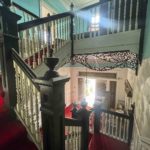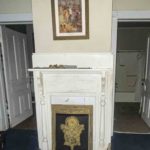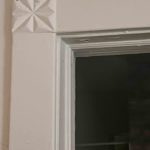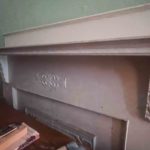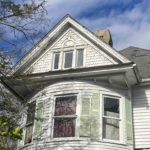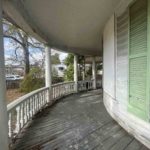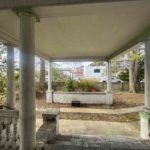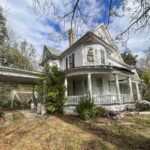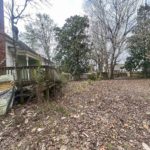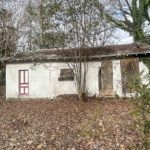J.W. Higgs House – UNDER CONTRACT
- $142,500
- 4,811 square feet
- Lot Size: 0.82 acres / Zoning: CDF (Downtown Commercial Fringe)
Maggie Gregg, Regional Director
Preservation North Carolina, Eastern Office
919-832-3652 ext. 242,
mgregg@presnc.org
UNDER CONTRACT
Elaborately detailed Queen Anne Revival and locally designated landmark with a remarkably intact interior! It’s prime location adjacent to the Dickinson Avenue Historic District and between the campus of East Carolina University and ECU Health Medical Center in Greenville provides a unique opportunity for a multitude of adaptive reuses.
Architectural and Historical Information
The circa 1905 J.W. Higgs House is one of the last remaining historic houses located in one of Greenville’s oldest neighborhoods. The Higgs neighborhood was developed around the turn of the century by Jacob W. Higgs and his brothers, Edward B. and Joseph Sydney Higgs. By March 1898, the Higgs brothers had acquired 30 acres, which they subdivided into lots and put up for sale. They also offered financing for construction of the houses.
The J.W. Higgs House was designed to be a showplace with its construction beginning in 1902, and not being completed until 1905. The height of architectural style, the exterior is asymmetrically massed with a two-story bay, which is echoed in the wrap around porch, two one-story rear ells, and seven cross gables, all architectural features Mrs. Higgs insisted upon in the design of the house.
Greeted by an impressive stair with two sets of risers leading to a central landing, detailed wainscoting, elaborate newel posts, and turned Eastlake spindlework, the spectacular entryway also features ornate pressed tin ceiling. The impressive woodwork was purchased from the Morgan Millwork Company in Baltimore.
Mrs. Higg’s brother, Howard Dixon, was a roofer and tinsmith from Rocky Mount. He installed the original slate roof (which has been replaced with architectural shingles) along with elaborate decorative metal embossed ceilings, each unique in style, throughout the main rooms in the house on both the first and second floors. At the time the ceilings were designed, electricity was not yet available in Greenville. However, the designs were planned with a round embossed area in which light fixtures could be added once electricity became available, which occurred in 1908.
The front door features a leaded glass transom, and according to family records, the windows, doors, and leaded glass were ordered from Chicago. Correspondence between Mr. Higgs and the McClamrock Mantel Company in Greensboro dating from November 1904 to January 1905, describe the order of mantels, tile hearths, facings and frames, and summer fronts for each of the eight mantels. The majority of the mantels are still present today.
The original J.W. Higgs House design included a basement to accommodate a steam heating system, as well as two bathrooms, one upstairs and one down, although neither heating nor plumbing were available at the time in Greenville. In 1914, a porte cochère was added to the left elevation to accommodate automobiles.
For a brief time in the 1970’s, the J.W. Higgs House was converted into The Gathering Place Restaurant. The restaurant was run by two ECU professors and described as featuring the “foods of the world,” with a rotating menu of two three-course meals and a selection of American and European wines chosen to compliment the daily menu.
In 1987, the Higgs family sold the property to Bishop Arizona H. Hartsfield and James. A Brown, outstanding members of the Greenville community. Hartsfield and Brown ran Faith House, a Christian based organization associated with Selvia Free Will Baptist Church, for three decades. They helped provide a safe haven for the unhoused, and helped those leaving prison to transition and reintegrate back into the community.
The J.W. Higgs House will require complete and sensitive rehabilitation, including a new roof, replacement of systems, and restoration of important architectural features. Local landmark designation provides for a 50% property tax deferral with required yearly application process.
The City of Greenville Town Council approved demolition of the J.W. Higgs House in January 2024, and a 365-day delay of demolition was issued March 26, 2024 by the Historic Preservation Commission. Buyers will need to work collaboratively with Preservation North Carolina, the City of Greenville staff, and the Historic Preservation Commission on restoration to ensure significant progress is made before the demolition delay deadline.
Area Information
Located in the heart of Eastern NC, Greenville is home to East Carolina University and ECU Health Center, and has a vibrant and growing population (currently 90,000). The Dickinson Avenue Historic District and Uptown Greenville are home to many popular restaurants, breweries, and shops. This popular area is located adjacent to the Town Common, which runs along the Tar River and provides access for boating and kayaking, and also hosts many festivals and live music events.
Click here to view the brochure for the J.W. Higgs House
Click here to view a video tour of the J.W. Higgs House












